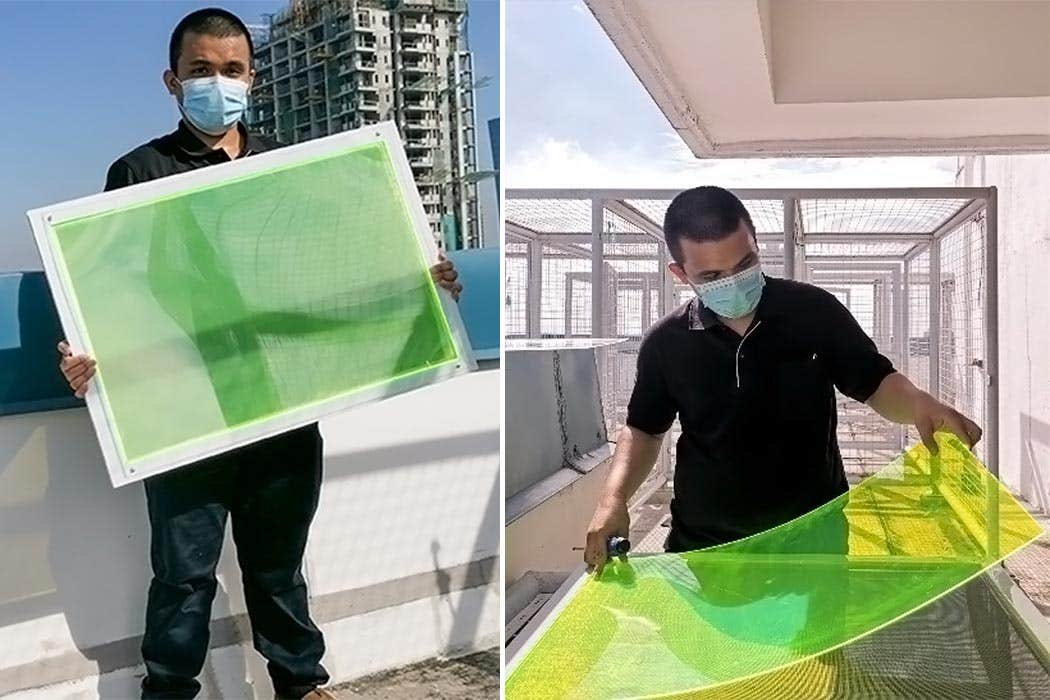AuREUS solar panels made from recycled food waste generate energy without sunlight
Fossil fuels continue to account for over 81% of global energy production and global supplies of gas and oil will deplete by 2060.

[Nov 17, 2022: Chris Young]
Carvey Ehren Maigue holding up one of his prototype panels. (CREDIT: James Dyson Foundation)
Sustainability is the next big movement when it comes to design, it is something every industry will have to apply and one of the most interesting parts of it is material exploration – what substitutes can we use or tweaks can we make to optimize our resources for the betterment of the climate?
Fossil fuels continue to account for over 81% of global energy production according to the International Energy Agency and if we continue to burn fossil fuels at the current rate, global supplies of gas and oil will deplete by 2060.
Solar panels are a cornerstone of the clean energy revolution. And yet, they have one great flaw: when the clouds roll in their productivity dives.
Now, a new type of solar panel has been developed by an electrical engineering student at Mapua University that harvests the unseen ultraviolet light from the sun that makes it through even dense cloud coverage.
Related Stories
Carvey Ehren Maigue, who won the James Dyson Sustainability Award for his creation, hopes it will soon be used on the windows and walls of large buildings, turning them into constant sources of energy.
Solar panels that don't rely on visible sunlight
The concept, called AuREUS (which stands for Aurora Renewable Energy and UV Sequestration), uses luminescent particles from fruit and vegetable waste that absorb UV light and convert it into visible light. A solar film then converts that visible light into energy.
"It’s similar to how we breathe in oxygen and we exhale carbon dioxide," Maigue said. "It takes in ultraviolet light, and then after some time it would shed it as visible light."
Maigue's prototype for AuREUS is a single 3-by-2-foot lime gree-tinted panel that he installed in the window in his apartment. In his demonstration for the James Dyson Award, he showed that his test panel can generate enough electricity to charge two phones per day. Scaled up, Maigue says these panels would enable buildings to run entirely on their own electricity.
Democratizing renewable energy
The creator also says the flexibility of the material — the resin can even be applied to fabric for clothing — allows designers to use the panels in a variety of different, innovative designs that could help more people to understand and adopt renewable energy solutions.
"If we can democratize renewable energy, we can bring it both physically closer to people as well as psychologically closer," Maigue explained. "It would give them a sense of access to it, that they are closer to it, that they don’t have to be large institutions that have the capability to harvest solar energy with their rooftops."
Apart from lowering costs, mitigating climate change, and supporting local agricultural communities, these panels will also reduce people’s exposure to radiation that can cause serious diseases and help in reducing the urban carbon footprint with sustainable architecture.
“I want to create a better form of renewable energy that uses the world’s natural resources, is close to people’s lives, forging achievable paths and rallying towards a sustainable and regenerative future,” says Maigue. His invention is both future-looking and problem-solving for the present.
Maigue's next step is to develop his first building installation of AuREUS at a small medical clinic on the island of Jomalig, off the Philippine mainland, that is frequently left without power during storms.
For more information on AuREUS take a look at the James Dyson Foundation video above.
For more environmental news stories check out our Green Impact section at The Brighter Side of News.
Note: Materials provided above by Chris Young. Content may be edited for style and length.
Like these kind of feel good stories? Get the Brighter Side of News' newsletter.
Joseph Shavit
Head Science News Writer | Communicating Innovation & Discovery
Based in Los Angeles, Joseph Shavit is an accomplished science journalist, head science news writer and co-founder at The Brighter Side of News, where he translates cutting-edge discoveries into compelling stories for a broad audience. With a strong background spanning science, business, product management, media leadership, and entrepreneurship, Joseph brings a unique perspective to science communication. His expertise allows him to uncover the intersection of technological advancements and market potential, shedding light on how groundbreaking research evolves into transformative products and industries.



